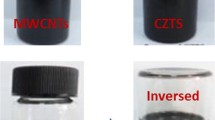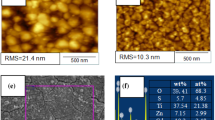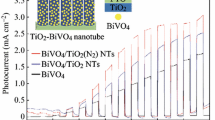Abstract
This work highlights the potential of carbon nanotubes (CNTs) and Cu2ZnSnS4 quantum dots (CZTS QDs) for enhancing the photoelectrochemical properties of TiO2 thin film. A combination of eco-friendly materials with a simple approach to synthesis makes the system effective. The photoelectrodes have been prepared by depositing CZTS QDs over both TiO2 as well as TiO2–CNT composite. An enhanced photocurrent density of 1.5 mA cm−2 at 1.23 V/RHE has been observed for CZTS QDs modified TiO2–CNT composite which is 15-fold increased in contrast to pristine TiO2. Here, CZTS QDs, as well as CNTs both, provide a widening of the light absorption characteristics of TiO2 from UV to the visible region. Further, the p–n junction created between CZTS QDs and TiO2–CNT plays a crucial role in charge separation process through electric field generated at the junction. Various characterization techniques have been used for structural, morphological and optical properties analysis. The increased photoelectrochemical (PEC) performance of photoelectrode has been justified with the help of UV–Vis spectra, Mott–Schottky, Nyquist and transient open circuit potential plots.






Similar content being viewed by others
Data availability
Data sharing not applicable to this article as no datasets were generated or analyzed during the current study.
References
M. Safaei, M.R. Shishehbore, J. Mater. Sci. 56, 17942–17978 (2021). https://doi.org/10.1007/s10853-021-06428-6
C. Ros, T. Andreu, J.R. Morante, J. Mater. Chem. A 8(21), 10625–10669 (2020). https://doi.org/10.1039/D0TA03271A
T.N. Trung, N.T.T. Kieu, D.Q. Ho, D.B. Seo, E.T. Kim, J. Mater. Sci. 58, 2156–2169 (2023). https://doi.org/10.1007/s10853-023-08158-3
R.V.D. Krol, Photoelectrochemical hydrogen production, in Principles of Photoelectrochemical Cells. ed. by R.V.D. Krol, M. Gratzel (Springer, New York, 2012), pp.13–67
E.L. Miller, Solar hydrogen production by photoelectrochemical water splitting: the promise and challenge, in On Solar Hydrogen and Nanotechnology. ed. by L. Vayssieres (Wiley, New York, 2009), pp.3–35
A. Ikram, S. Sahai, S. Rai, S. Dass, R. Shrivastav, V.R. Satsangi, Phys. Chem. Chem. Phys. 18(23), 15815–15821 (2016). https://doi.org/10.1039/C6CP00854B
E. Vahidzadeh, S. Zeng, K.M. Alam, P. Kumar, S. Riddell, N. Chaulagain, S. Gusarov, A.E. Kobryn, K. Shankar, ACS Appl. Mater. Interfaces. 13(36), 42741–42752 (2021). https://doi.org/10.1021/acsami.1c10698
M. Israr, F. Raza, N. Nazar et al., Appl. Nanosci. 10, 3805–3817 (2020). https://doi.org/10.1007/s13204-020-01474-z
Z. Hou, Y. Li, J. Liu, H. Shen, X. Huo, New J. Chem. 45(3), 1743–1752 (2021). https://doi.org/10.1039/D0NJ05250G
S. Rai, A. Ikram, S. Sahai, S. Dass, R. Shrivastav, V.R. Satsangi, Int. J. Hydrog. Energy 42(7), 3994–4006 (2017). https://doi.org/10.1016/j.ijhydene.2016.10.024
W. Zhang, G. Li, H. Liu, J. Chen, S. Ma, T. An, Environ. Sci. Nano 6(3), 948–958 (2019). https://doi.org/10.1039/C8EN01375F
G.S. Selopal, M. Mohammadnezhad, L.V. Besteiro, O. Cavuslar, J. Liu, H. Zhang, F. Rosei, Adv. Sci. 7(20), 2001864 (2020). https://doi.org/10.1002/advs.202001864
D. Chaudhary, S. Singh, V.D. Vankar, N. Khare, Int. J. Hydrog. Energy 42(12), 7826–7835 (2017). https://doi.org/10.1016/j.ijhydene.2016.12.036
S. Kumari, Y.S. Chaudhary, S.A. Agnihotry, C. Tripathi, A. Verma, D. Chauhan, V.R. Satsangi, Int. J. Hydrog. Energy 32(9), 1299–1302 (2007). https://doi.org/10.1016/j.ijhydene.2006.07.017
W.C. Liu, B.L. Guo, X.S. Wu, F.M. Zhang, C.L. Mak, K.H. Wong, J. Mater. Chem. A 1(9), 3182–3186 (2013). https://doi.org/10.1039/C3TA00357D
L.J. Diguna, Q. Shen, J. Kobayashi, T. Toyoda, Appl. Phys. Lett. 91(2), 023116 (2007). https://doi.org/10.1063/1.2757130
P. Makuła, M. Pacia, W. Macyk, J. Phys. Chem. Lett. 9(23), 6814–6817 (2018). https://doi.org/10.1021/acs.jpclett.8b02892
A.W. Bott, Curr. Sep. 17, 87–92 (1998)
A. Zaban, M. Greenshtein, J. Bisquert, ChemPhysChem 4(8), 859–864 (2003). https://doi.org/10.1002/cphc.200200615
H. Dotan, N. Mathews, T. Hisatomi, M. Grätzel, A. Rothschild, J. Phys. Chem. Lett. 5(19), 3330–3334 (2014). https://doi.org/10.1021/jz501716g
F. Su, J. Lu, Y. Tian, X. Ma, J. Gong, Phys. Chem. Chem. Phys. 15(29), 12026–12032 (2013). https://doi.org/10.1039/C3CP51291F
V. Agrawal, K. Jain, R. Pasricha, S. Chand, J. Nanopart. (2013). https://doi.org/10.1155/2013/685836
M.A. Basit, F. Raza, Sumayya, G. Karima, I. Ali, S. Butt, J. Mater. Sci. 31, 17563–17573 (2020). https://doi.org/10.1007/s10854-020-04312-8
M. Ocana, J.V. Garcia-Ramos, C.J. Serna, J. Am. Ceram. Soc. 75(7), 2010–2012 (1992). https://doi.org/10.1111/j.1151-2916.1992.tb07237.x
A.D. Dobrzańska-Danikiewicz, W. Wolany, D. Łukowiec, K. Jurkiewicz, P. Niedziałkowski, Nanomater. Nanotechnol. 7, 1847980417707173 (2017). https://doi.org/10.1177/1847980417707173
R. Ahmad, M. Distaso, H. Azimi, C.J. Brabec, W. Peukert, J. Nanopart. Res. 15, 1–16 (2013). https://doi.org/10.1007/s11051-013-1886-9
D. Thangaraju, R. Karthikeyan, N. Prakash, S.M. Babu, Y. Hayakawa, Dalton Trans. 44(33), 15031–15041 (2015). https://doi.org/10.1039/C5DT01542A
M. Dimitrievska, F. Boero, A.P. Litvinchuk, S. Delsante, G. Borzone, A. Perez-Rodriguez, V. Izquierdo-Roca, Inorg. Chem. 56(6), 3467–3474 (2017). https://doi.org/10.1021/acs.inorgchem.6b03008
L. Arora, V.N. Singh, G. Partheepan et al., Appl. Nanosci. 7, 499 (2017). https://doi.org/10.1007/s13204-015-0404-z
M.B. Poudel, C. Yu, H.J. Kim, Catalysts 10(5), 546 (2020). https://doi.org/10.3390/catal10050546
H.A. Park, S. Liu, Y. Oh, P.A. Salvador, G.S. Rohrer, M.F. Islam, ACS Nano 11(2), 2150–2159 (2017). https://doi.org/10.1021/acsnano.6b08387
J.X. Xu, Y. Yuan, M. Liu, S. Zou, O. Chen, D. Zhang, Anal. Chem. 92(7), 5346–5353 (2020). https://doi.org/10.1021/acs.analchem.0c00016
B. Klahr, S. Gimenez, F. Fabregat-Santiago, T. Hamann, J. Bisquert, J. Am. Chem. Soc. 134(9), 4294–4302 (2012). https://doi.org/10.1021/ja210755h
M. Muhibbullah, A.M.A. Haleem, Trans. Mater. Res. Soc. Jpn 40(3), 247–252 (2015). https://doi.org/10.14723/tmrsj.40.247
M. Zhong, T. Hisatomi, Y. Kuang, J. Zhao, M. Liu, A. Iwase, K. Domen, J. Am. Chem. Soc. 137(15), 5053–5060 (2015). https://doi.org/10.1021/jacs.5b00256
J. Su, P. Geng, X. Li, Q. Zhao, X. Quan, G. Chen, Nanoscale 7(39), 16282–16289 (2015). https://doi.org/10.1039/C5NR04562B
C. Liu, T. Zhang, D. Zhao, C. Zhang, G. Ou, H. **, Z. Chen, J. Mater. Sci. 32, 7061–7072 (2021). https://doi.org/10.1007/s10854-021-05416-5
D.S. Ellis, Y. Piekner, D.A. Grave, P. Schnell, A. Rothschild, Front. Energy Res. 9, 924 (2022). https://doi.org/10.3389/fenrg.2021.726069
M. Grätzel, Nature 414(6861), 338–344 (2001). https://doi.org/10.1038/35104607
M. Sridharan, P. Kamaraj, Y.S. Huh, S. Devikala, M. Arthanareeswari, J.A. Selvi, E. Sundaravadivel, Catal. Sci. Technol. 9(14), 3686–3696 (2019). https://doi.org/10.1039/C9CY00429G
Acknowledgements
One of the authors (Ashi Ikram) is grateful for the financial support provided by University Grants Commission (UGC) New Delhi, India under Dr. D. S. Kothari Postdoctoral Fellowship Scheme; vide section No.F.4-2/2006 (BSR)/PH/19-20/0067 to carry out the research. Authors are thankful to Central Instrumentation facility (CIF), Jamia Millia Islamia, New Delhi and IIT, Delhi for Raman spectroscopy and HRTEM characterizations respectively. We are also thankful to Prof. Vibha R. Satsangi, Head, Deptt. of Physics and Comp. Science, and Prof. Sahab Dass, Head, Deptt. of Chemistry, Dayalbagh Educational Institute, Agra for utilization of their characterization facilities like FESEM, Potentiostat and UV–vis diffuse reflectance spectrometer.
Funding
This work was supported by University Grants Commission (UGC) New Delhi, India under Dr. D. S. Kothari Postdoctoral Fellowship Scheme; vide section No.F.4-2/2006 (BSR)/PH/19-20/0067.
Author information
Authors and Affiliations
Contributions
AI is responsible for conceptualization, methodology, analysis and investigation, writing and visualization. MZ is responsible for conceptualization, Writing—Review and Editing, and supervision. All authors read and approved the final manuscript.
Corresponding author
Ethics declarations
Conflict of interest
The authors have no relevant financial or non-financial interests to disclose.
Additional information
Publisher's Note
Springer Nature remains neutral with regard to jurisdictional claims in published maps and institutional affiliations.
Supplementary Information
Below is the link to the electronic supplementary material.
Rights and permissions
Springer Nature or its licensor (e.g. a society or other partner) holds exclusive rights to this article under a publishing agreement with the author(s) or other rightsholder(s); author self-archiving of the accepted manuscript version of this article is solely governed by the terms of such publishing agreement and applicable law.
About this article
Cite this article
Ikram, A., Zulfequar, M. Elucidating the role of CZTS QDs and CNTs for boosting the photoelectrochemical response of TiO2. J Mater Sci: Mater Electron 34, 1769 (2023). https://doi.org/10.1007/s10854-023-11141-y
Received:
Accepted:
Published:
DOI: https://doi.org/10.1007/s10854-023-11141-y




